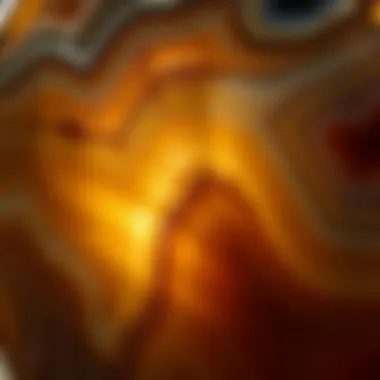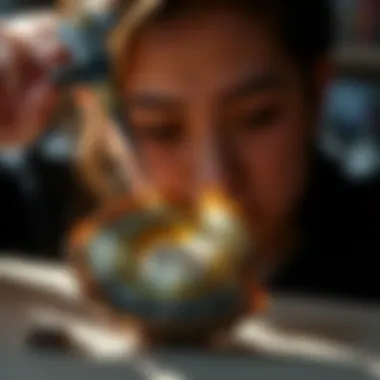Understanding Agate Stone Pricing: Key Factors


Intro
Agate stones, with their mesmerizing banding and rich colors, have captivated collectors and enthusiasts alike. These natural marvels, part of the quartz family, possess unique geological traits that play a significant role in their pricing. Understanding why certain agates command higher prices involves delving into several factors. It goes beyond mere aesthetics; the stones' origin, rarity, and even market demand contribute to their value. This guide aims to be your compass in navigating the intricate world of agate stones, whether you're a seasoned collector or an alluring newbie.
Rock and Fossil Identification
Gaining insights into agates starts with recognizing their particular characteristics. Understanding how to identify different types of agate can sharpen your collecting skills.
Types of Rocks and Fossils
Agate itself comes in a plethora of varieties:
- Botswana Agate
Known for its soft, pastel colors and distinctive banding patterns. - Moss Agate
Features green or brown moss-like inclusions, evoking a natural landscape. - Fire Agate
Displays a play of color that changes under light, often with a deep reddish hue.
Each variety beckons with its own allure, inviting collectors to explore. Fossils, while not agates, are often found in similar collecting sites. Identifying those unique fossils amid the rocks can add depth to your collection.
Characteristics to Look For
When sifting through rocks, consider the following:
- Color: The chromatic diversity can hint at the stone's type and value.
- Pattern: Banding, mottling, or layering can indicate a high-quality agate.
- Clarity: A clear stone often commands a higher price than one with a lot of inclusions.
Tools for Identification
Having the right tools can make all the difference in the field. Consider packing:
- A hand lens or magnifying glass to examine fine details.
- A field guide focusing on agate types and fossil identification.
- Collecting bags to organize your finds and protect them.
Collecting Tips and Techniques
Finding the perfect piece isn't just about luck; employing effective techniques can enhance your success.
Best Practices for Collecting
Collecting agate stones requires a respectful approach to nature. Keep these practices in mind:
- Research local laws regarding rock collection to avoid fines.
- Collect responsibly and leave no trace to maintain ecosystem balance.
Locating Prime Collecting Sites
Certain geographical locations are renowned for agate abundance. Popular spots include the following:
- Oregon Coast, USA: Known for its beautiful beach agates.
- Lake Superior, USA: Houses some of the best agate finds available.
- Brazil: Famous for vibrant agate specimens.
How to Safely Extract Specimens
Take care when removing stones:
- Use hand tools like small hammers or chisels for careful extraction.
- Always wear gloves to protect your hands from sharp edges.
Preservation and Display
Once you’ve collected your agates, knowing how to display and preserve them retains their beauty and value.
Techniques for Preserving Rocks and Fossils
To ensure your finds stand the test of time:
- Keep them in a cool, dry place to prevent moisture damage.
- Use anti-tarnish strips in storage to maintain their shine.
Proper Storage Methods
To effectively store your collection:
- Use display cases to avoid scratches.
- Consider labels for each piece to note its type, origin, and any unique features.
Creative Display Ideas
Show off your collection with flair. Think about:
- Shadow boxes to create a layered look with depth.
- Tabletop displays using glass domes for a modern touch.
Geological Insights


A nuanced understanding of geology not only adds value to your collection, but also enriches the story behind each piece.
Geological Formations and Processes
Agates form in lava flows and sedimentary structures, where silica-rich fluids flow through volcanic rocks. Understanding this process is vital to understanding why certain agates are rare.
Historical Significance of Rocks and Fossils
Agate stones aren’t just beautiful; they have been utilized throughout history. From protective amulets in ancient cultures to stunning jewelry pieces today, their significance is enduring.
Notable Discoveries in the Field
There have been striking finds in the agate world:
- The Great Lakes Agate, with stunning patterns, remains a collector's favorite.
- Brazilian agates, known for their vibrant colors, often attract international buyers.
"Every agate tells a story; understand this, and you’ll appreciate the true value of each piece you collect."
This comprehensive guide sets the stage for a well-rounded understanding of agate stones, their pricing factors, and the broader realm of rock collecting. Embrace the adventure, and let your pursuit of knowledge enrich your collection.
Preface to Agate Stones
Agate stones, with their unique formations and vivid colors, are a fascinating topic for collectors and enthusiasts alike. Understanding these stones goes beyond mere interest; it encompasses knowledge about their geological origins, various types, and the value they hold in both natural and crafted forms. This section serves as an essential groundwork, paving the way for a more nuanced discussion about pricing in later sections.
The world of agate is rich with diversity. Each stone tells a story, shaped by millions of years of geological processes. For rock and fossil collectors, getting a grip on the fundamental aspects of agate not only enriches their collection but also enhances their appreciation of the craftsmanship behind carving and polishing these marvelous stones.
Definition and Geological Background
Agate is a type of chalcedony, a mineral belonging to the quartz family. Its formation occurs when silicon dioxide precipitates from mineral-rich waters or traps gas bubbles during cooling. What makes agate striking is its banded structure, often affected by variations in mineral content and the conditions under which it forms. Such factors implement a unique geological fingerprint on each stone.
In essence, agate stones are layers and layers of deposited minerals, creating those alluring patterns that collectors adore. The geological backgrounds differ vastly, from volcanic flows to sedimentary formations, contributing to the stones' characteristics. This understanding can elevate a collector’s ability to distinguish quality stones and recognize where they fit in the broader scheme of geological history.
Types of Agate
The diversity of agate comes into play when discussing its various types. Each subsection possesses distinct features and applications, providing collectors an opportunity to imbibe their passions. Here’s a quick look at some noteworthy varieties:
- Botryoidal Agate: Renowned for its rounded, grape-like formations. Its distinct look can captivate any collector. The spherical nodules create a textured aesthetic that’s not only visually appealing but also unique in its composition. Many treasure its smooth surface that can almost feel like a massage to the fingertips.
- Moss Agate: This variety stands out with its green, moss-like inclusions. The unique feature is its depiction of landscapes—a visual storytelling of nature captured in stone. This characteristic makes moss agate a favored choice for artistic pieces, jewelry, and decorative objects. The charm of this stone lies in its ability to evoke images of forests and meadows, connecting its owner back to nature.
- Fire Agate: Famous for its fiery flash and vibrant hue, commonly ranging from reds to oranges. Fire agate may seem mundane at first, but when held up to light, it reveals deep iridescent colors that can take one’s breath away. Collectors often find the challenge in properly cutting and polishing fire agate rewarding, as it can transform a rough stone into a spectacle of beauty.
- Lace Agate: As the name suggests, lace agate features delicate, lace-like patterns. Its uniqueness lies in the soft, flowing lines that resonate tranquility. Many collectors appreciate its subtle aesthetics, making it a perfect addition for those seeking serene pieces that balance energy. The varying colors can add depth to a collection while showcasing the elegance of just how intricate nature can be.
Recognizing the types of agate and their individual characteristics aids collectors in making informed decisions about their purchases. It enhances their understanding of the market, and amplifies and appreciation for the very stones they seek to own.
"In the realm of stones, agate is not just an ornament; it is a narrative of the Earth, sculpted through time."
Understanding agate stones is a vital step toward successfully navigating the collection and market landscape, setting the stage for deeper dives into the intricate factors that influence their pricing.
Factors Influencing Agate Prices
Understanding the pricing of agate stones is no small feat. It’s a tangled web where geological factors meet market dynamics. Knowing what drives the cost can be a game-changer for rock and fossil collectors. This section will lift the veil on the core elements affecting agate prices, helping readers make more informed decisions while navigating their collections.
Geological Rarity
Rarity stands as a backbone of value in gemstones, agate included. In the grand scheme of geology, not all agates are created equal. Owing to the specific conditions required for their formation, some types of agate are uncommon, making them more sought after. For example, Moss Agate has its own unique patterns that resemble a garden rooted in stone; it's not something you stumble upon at every corner, and that scarcity surely adds to its price tag.
Collectors need to consider geography as well. Certain regions may produce more of one type than another. Rocks sourced from ancient volcanic areas tend to exhibit more unique markings and colorations. The quality of the deposit and its historical extraction contributes greatly to its rarity and the premium collectors are willing to pay for them. If only they were as easy to find as pebbles on the beach, the market might look a whole lot different!
Color Variation and Aesthetic Appeal
Color is often the first thing to catch one’s eye. In the world of agate stones, color variation can make a substantial difference in pricing. Collector preferences sway toward vivid hues and unique patterns. Fire Agate, with its mesmerizing play of color and an almost fiery depth, tends to command higher prices. The richer and bolder the shades, the more desirable the stone typically is.
Different colors can also evoke different emotional responses, making some stones particularly appealing for specific uses, like jewelry or decorative pieces. It’s essential for collectors to not only appreciate the beauty but also understand how these shades affect market value. In essence, colors are not just pleasing to the eye; they hold economic power in the sphere of agate pricing.
Cut and Finish Quality
The manner in which agate is cut and finished can significantly influence its price. A rough-hewn rock, while beautiful in its own way, may not fetch the same dollars as a well-faceted piece. Quality cutting reveals the stone's vibrant colors and patterns, exploring its full potential.
For instance, stones that are polished to reveal a glass-like sheen tend to attract more buyers than those that are left in their natural state. A good rule of thumb is that the cleaner the cut, the higher the value. This aspect goes beyond just aesthetics; proper finishing can help prevent damage in the long run, making it a practical consideration for investment purposes.
Size and Weight Considerations
When it comes to agates, size does matter. Generally speaking, larger stones can sell for more. This isn’t a hard and fast rule, however. A small, beautifully patterned piece could outprice a larger stone that lacks appeal. It's the balance of size and unique characteristics that often plays a crucial role in determining worth.
Moreover, weight interacts with value in a more complex way. For example, while a hefty chunk of agate might be impressive, it’s the lightness that comes with intricate designs that often captures fascination. Collectors are sometimes on the lookout for stones that are both sizable yet possess that crucial aesthetic quality—an intriguing puzzle.
Keep in mind that when you’re considering both size and quality, it’s not all about what meets the eye. Often, the nuances hide beneath the surface, revealing value upon closer inspection.


Market Trends and Pricing
Understanding market trends and pricing is essential for anyone involved in the world of agate stones. Prices fluctuate based on a variety of factors such as geopolitical stability, demand, and even the whims of fashion. This section will delve into current market values, how global demand shapes those values, and the emerging market trends that anyone looking to invest in agate should be aware of. The insights here not only help potential buyers make informed decisions but also clarify why certain stones may command higher prices than others.
Overview of Current Market Values
The current market for agate stones varies widely, influenced significantly by their unique characteristics. Prices can range from a few dollars per carat for more common variants to thousands for exceptionally rare pieces. The valuation often relies on the quality of the stone, where factors like color saturation, pattern intricacy, and overall clarity play pivotal roles.
Generally, collectors can expect to see:
- Common Agate: $5 - $20 per carat
- Rare Varieties: $50 - $500 per carat
- Exceptional Collectible Pieces: $1,000 and above
These figures can fluctuate based on market sentiment and other emerging trends. Practically speaking, it's crucial for potential buyers to stay aligned with the latest data to ensure they don’t miss out on a good deal or overpay for a stone that lacks value.
Impact of Global Demand
Collector Interest
Collector interest stands out as a significant driver influencing agate prices. Enthusiasts and serious collectors are always on the lookout for unique patterns and colors that make their collections special. These collectors often place a premium on rarity; when a specific type of agate appears on the market, demand spikes, and so do prices.
For instance, the recent resurgence in popularity of Moss Agate, known for its intricate, nature-like patterns, has led to a marked rise in its market value. This spike demonstrates how passionate collectors can shape market trends. The uniqueness of each stone means that even smaller batches can quickly attract attention and sales. However, while collector interest can lead to gains, it can also result in over-inflated prices for stones that may not have sustainable long-term value.
Industrial Uses
On a different note, industrial uses of agate stones also contribute to price dynamics. Agate is utilized in various sectors including jewelry, home decor, and to a lesser extent, practical applications like cutting tools and abrasives. This industrial craving makes agate more than a collector's item; it cements its relevance in everyday applications.
Key benefits of industrial uses include:
- Broad Market Appeal: With applications that extend beyond aesthetics, agate holds steady value in the marketplace.
- Increased Demand: Industries needing resilient materials can drive demand for specific varieties of agate, leading to potential price hikes.
Nevertheless, the industrial sector might lead to prices that differ from the collector market, sometimes offering lower values compared to what an enthusiast might pay for a decorative piece.
Emerging Market Trends
As the world evolves, so do market trends within the agate sector. Increasing interest from new collectors, coupled with improving online marketplaces, have broadened purchasing options.
Some developing trends include:
- Online Auctions: Platforms like eBay and specialized gemstone websites allow enthusiasts to explore vast inventories.
- Sustainability: More collectors are seeking ethically sourced stones. This shift is making transparent sourcing a defining factor in pricing.
- Personalization: Customized jewelry featuring agate has gained traction, driving the need for stones that lend themselves to unique designs.
To summarize, monitoring market trends is vital not only for pricing strategy but also for analyzing where the market may be heading. This knowledge serves as a guiding compass for anyone looking to navigate the fascinating yet complex world of agate investment.
Grading Agate Stones
Grading agate stones is a critical element for collectors and investors alike. It helps in establishing the worth of a stone based on specific criteria, enabling a more informed purchasing decision. Just like fine art, the value of agate is often subjective yet rooted in observable characteristics. By understanding these grading standards, you can navigate the vibrant marketplace with greater confidence.
Standard Grading Criteria
When it comes to grading agate stones, there are a few key standards one ought to consider. These are usually not written in stone, so to speak, but they are generally accepted in the agate community. Here are some crucial grading criteria:
- Color: The vibrancy and variety of hues can boost a stone's desirability. A stone with rich, uniform colors tends to score higher.
- Pattern: Unique patterns, like banding or inclusions, add distinctsiveness. A stone showcasing an intricate or rare pattern is often more valuable.
- Clarity: A clear stone, showing few or no fractures, will typically fetch a better price than one that is cloudy or opaque.
- Size: Larger stones usually command higher prices, although exceptional patterns may outweigh size for small pieces.
It's essential to weigh these elements collectively rather than in isolation to reach an accurate grade.
Identifying Authenticity
Recognizing authentic agate stones isn’t just about a good eye; it's a skill set that grows with knowledge and experience. Many replicas or synthetics exist, and telling the difference can save you from a costly mistake. Some methods for identifying authenticity include:
- Visual Inspection: Look for natural imperfections. Authentic agate often has inclusions or minor blemishes, unlike flawless imitation stones.
- Touch and Feel: Genuine agate has a cool touch. If a stone feels warmer or unusually light, it might not be the real deal.
- Translucency Test: Hold the stone to the light. Real agates should allow some light through without appearing transparent.
- Sound: Tapping two stones together can produce a distinct sound. Higher-pitched tones often indicate authenticity.
This knowledge arms you with the capability to separate the wheat from the chaff when you find yourself at an agate show.
Role of Certification
Certification plays an invaluable role in the agate market, acting as a ticket to validate both authenticity and quality. Purchasing agate stones with certification from a reliable authority provides numerous benefits, including:
- Peace of Mind: Knowing your stone has been evaluated by experts takes the anxiety out of the buying process.
- Investment Security: Certified stones tend to retain value better over time. Having proof of quality and authenticity can serve as a safety net for future resale.
- Community Trust: A certificate can enhance your reputation as a collector, making you more credible in the eyes of peers and potential buyers.
In sum, grading agate stones fosters a profound understanding of their value and significance. Being well-versed in grading criteria, authenticity checks, and certification payoff offers collectors a robust toolkit to engage in this captivating pursuit.
Sourcing Agate Stones
Sourcing agate stones is a crucial component in understanding their pricing and overall value. This part of the process not only affects the availability and market situaiton but also influences the characteristics and quality of the stones you may wish to purchase. Knowing where and how to source these stones can provide collectors with dilegation advantages, as well as an edge in optimizing their investment potential.


Global Sources of Agate
Agate can be found all around the globe. That said, some regions are famous for their unique varieties and qualities that make them highly sought after. Here’s a look at some notable sources:
- Brazil: Known for vibrant colors and unique banding patterns. Brazilian agates often boast bright hues, appealing to collectors.
- Uruguay: Home to some of the world’s largest agate geodes, tourists and buyers flock to this country for its rare finds.
- Germany: Particularly in the region of Idar-Oberstein, this area has a rich history in agate mining and offers finely polished stones.
- United States: Arizona and Oregon are popular states for agate, with varieties like fire agate and moss agate attracting many collectors.
- India: Inexpensive and plentiful, India is a key supplier of agate stones for both the jewelry market and collectors.
When looking for agate stones, understanding where they originate aids in gauging their value. Stones from specific locales often carry different price tags based on their rarity and aesthetics.
Retail vs. Wholesale Market
When diving deeper into sourcing, one must consider the differences between retail and wholesale markets. Both avenues serve unique purposes depending on the collector’s intentions.
Retail Market
- Accessibility: Retailers often have stones pre-selected for their aesthetics and quality, making it easy for collectors to find what they are looking for.
- Convenience: Buying from local jewelers, rock shows, or online platforms usually offers a more convenient purchasing experience.
- Higher Prices: While retail is about convenience, it’s no secret that prices here can be higher, reflecting the added value of unique finds and the costs incurred by the retailer.
Wholesale Market
- Bulk Purchases: For serious collectors looking to add significant numbers to their collection or resellers aiming to profit from the market, wholesale options are appealing. They can usually buy in larger quantities for lower prices.
- Variety of Choices: Wholesale suppliers can provide a wider range of stones, including lesser-known varieties that may not be available at retail stores.
- Requires Diligence: While it can be cheaper, purchasing at the wholesale level involves more research to ensure authenticity and quality. It's important to connect with reputable suppliers and understand market trends.
Sourcing agate stones is both an art and a science. Awareness of global sources and the differences between retail and wholesale markets empowers collectors to make well-informed decisions. As you navigate the captivating world of agate stones, remember that knowledge truly is power.
Investing in Agate
When diving into the intricate world of agate stones, one cannot overlook the prospect of investing in them. While many view these stones purely as collectibles, there lies a vast landscape of financial opportunity beneath their colorful surfaces. Investing in agate can be rewarding but requires an understanding of the nuances associated with their market value, rarity, and aesthetic appeal. For rock and fossil enthusiasts, this section serves as a crucial map designed to navigate the waters of agate investment.
Agate stones come in a whirlwind of colors and patterns. This variation not only adds to their beauty but also their value. Collectors often seek after pieces that exhibit unique designs or rare colorations. What this means for investors is that the potential for value appreciation can be significant. A beautiful, high-quality piece of agate may not only retain its value but can appreciate over time as more people become interested in collecting.
"As the saying goes, beauty is in the eye of the beholder; in the case of agate, that beauty can translate into investment value."
Potential for Value Appreciation
In the realm of investing in agate, one of the most enticing elements is its potential for value appreciation. Like any other form of investment, the right pieces can yield impressive returns. A collector who carefully chooses their agate, based on trends and rarity, may find themselves holdng a prized possession that increases in worth as demand rises.
Factors that drive value appreciation include:
- Rarity: Certain types of agate, particularly those that are hard to find or have distinctive characteristics, can command higher prices.
- Market Trends: Staying aware of market trends helps collectors understand which pieces are gaining popularity. As fashion and trends shift, so do the desirability of specific agate variations.
- Condition and Quality: Just like real estate, condition is key. Well-maintained stones can fetch a premium.
In some cases, particularly unique pieces might fetch thousands of dollars! Investing in agate doesn’t just serve as a financial asset, but can also be a delightful journey into natural beauty and science.
Risks and Considerations
However, it is also important to be mindful of the risks involved in investing in agate. While the potential for great returns exists, buyers should proceed with caution.
Here are some considerations every investor should keep in mind:
- Market Volatility: The market for collectibles can fluctuate, and agate stones are no exception. Preferences can shift, leaving some stones valued less than expected.
- Authenticity and Certification: Ensuring that an agate stone is genuine can be challenging. Ease of access to counterfeit stones makes it crucial for buyers to seek certification and do thorough research.
- Long-Term Investment: While some may consider agate a lucrative short-term investment, it's often a more wise decision to view it as a long-term endeavor, as its appreciation may take time.
The path to successful investing in agate stones involves balancing the potential for returns with an understanding of the market dynamics and being ready to adapt as trends evolve. It’s not merely about buying pretty stones, but engaging in an investment that can tell a story and perhaps one day yield financial rewards.
Care and Maintenance of Agate
Caring for agate stones goes beyond mere aesthetic appeal; it plays a crucial role in preserving their integrity and ensuring their longevity. These stones, known for their vibrant colors and stunning banding, require attention to both cleaning and storage to maintain their beauty and value. Proper care can keep them looking pristine and may even enhance their market worth. Collectors, who invest time and resources in acquiring unique specimens, must be diligent in this crucial aspect of ownership.
Cleaning Techniques
To maintain the luster of agate stones, regular cleaning is essential. However, it’s important to approach the task with care to avoid scratching or damaging the surface. Here are some effective methods:
- Gentle Soap Wash: Use a mild dish soap diluted in lukewarm water. Soak a soft cloth or sponge and gently wipe the surface of the stone. Avoid abrasive cleaners, as they can cause micro-scratches that ruin the finish.
- Soft Brush Method: For those small crevices or intricate patterns, a soft-bristled toothbrush or a makeup brush works wonders. Dip it in soapy water and lightly brush the areas that need attention, then rinse off with clean water.
- Drying: After cleaning, ensure the stone is dried properly. Use a soft, lint-free cloth to absorb any excess moisture. Make sure it’s completely dry before storing to prevent mold or mineral buildup.
"A clean agate not only looks better but can also spark conversations among collectors."
Storage Recommendations
Storing agate stones correctly is as vital as cleaning them. Proper storage safeguards against damage and preserves their beauty for years. Here are some practical tips on how to store agate:
- Use Soft Linings: Store agate in a box lined with soft fabric to prevent scratching. Research shows that direct contact with hard surfaces can lead to chips and breakage.
- Separate Each Piece: Avoid stacking. When agate stones come into contact with one another, the potential for scratches increases. Use individual compartments or keep them in separate pouches.
- Temperature and Humidity Control: Store agate in a dry, cool place. Temperatures that are too high or humidity that is too pronounced can affect the stone’s natural beauty and structure.
- Away from Direct Sunlight: Prolonged exposure to sunlight can cause fading of certain colors. Therefore, it's best to keep them in a shaded area, away from windows.
By adhering to these recommended cleaning and storage techniques, collectors can ensure their agate stones remain in exemplary condition. A little effort goes a long way in protecting not just the stones themselves, but the investment that they represent.
Closure
In wrapping up the exploration into the price of agate stone, it’s crucial to recognize that this topic is woven with numerous strands—each significant in understanding the multifaceted nature of agate pricing. We’ve journeyed through the geological rarity, color variations, and cut quality that play pivotal roles in determining market value. With this knowledge in hand, collectors and enthusiasts can navigate the agate world with greater confidence.
The emphasis on sourcing, grading, and investment potential adds layers to the conclusions drawn within this guide. By comprehending the various factors influencing prices, one can avoid the pitfalls that often accompany gemstone acquisition. Understanding the landscape of agate prices allows collectors to make choices that align with both their passion for collecting and their financial goals.
Summarizing Key Points
- Geological Rarity: Certain types of agate, especially those with unique formations, hold higher value due to their scarcity in nature.
- Color and Aesthetic Appeal: The vibrancy and uniqueness of colors can significantly affect pricing. The more striking the appearance, the better it often sells.
- Cut and Finish Quality: Well-cut stones that showcase the natural beauty of agate tend to command higher prices. A good finish can make a world of difference.
- Market Trends: Staying informed about current market dynamics is essential for both buying and selling. Awareness of global demand can help in understanding potential price fluctuations over time.
- Investment Viability: The potential for value appreciation in agate stones is alluring. However, one must weigh the risks and rewards, as not every stone is a sound investment.
- Care and Maintenance: Proper care ensures longevity and preserves the beauty of agate stones, thus protecting their value.
Ultimately, the guiding principles discussed throughout the article equip collectors with the insights needed to approach buying and selling agate stones judiciously. A well-armed collector is more likely to thrive in this vibrant marketplace, making informed decisions that resonate with personal tastes and financial objectives.







